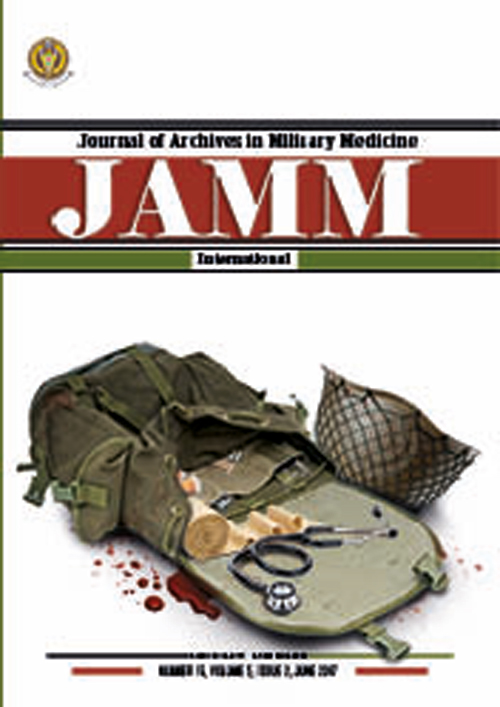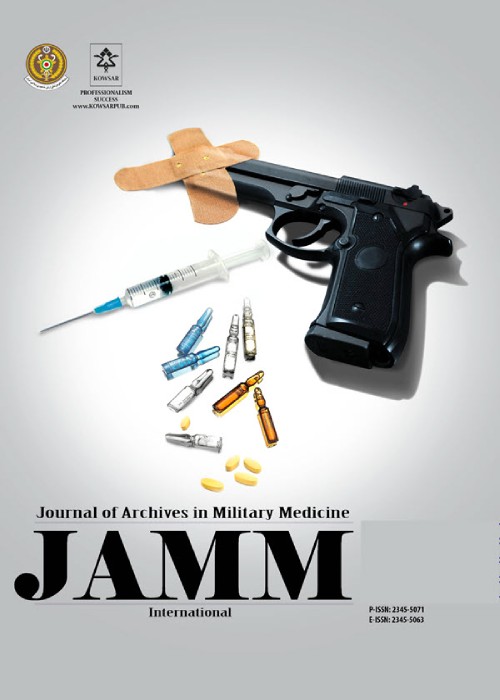فهرست مطالب

Journal of Archives in Military Medicine
Volume:5 Issue: 2, Jun 2017
- تاریخ انتشار: 1396/04/04
- تعداد عناوین: 8
-
-
Page 2BackgroundDespite numerous health promotion interventions lately conducted, the human immunodeficiency virus (HIV) remains a major cause of morbidity and mortality in sub-Saharan Africa. It is reported that military personnel have a higher prevalence of HIV, compared with the general population. Condom use remains a cheap, easy-to-use, and effective device to prevent the spread of HIV. Growing evidence, however, suggests its underuse among the military personnel.MethodsThe current cross sectional study included 325 consenting male and female soldiers from 8 different battalions. Characteristics of the study participants were summarized using frequencies and proportions. Associations between the studied variables were investigated using the Chi-square test of independency; P valuesResultsOnly 28% of the participants used condom during the last unsafe sexual contact. Over 85% of them reported that condoms were always available. Half (50%) of the participants were ashamed to buy condoms. The most commonly reasons for not using condoms were drunkenness (37.5%), trust in the sexual partner (26.5%), tobacco smoking (11.1%), not interested to use a condom (8.9%), and dislike/refusal of condom use by the partner. Main reasons of inconsistent use of condoms included drunkenness, shyness to buy condoms and unavailability in the respective battalions. Trust in sex partners, condom use/sex related stigma, and alcohol abuse were the major determinants of inconsistent condom use during unsafe sexual relations among Cameroonian soldiers.ConclusionsUnprotected sexual practice amongst Cameroonian soldiers was high. Despite the reported high availability of condoms (85%), only 28% of the study respondents used condoms during their last sexual intercourse with different partners. Consistent condom use was sub-optimal among Cameroonian military staff.Keywords: HIV, Soldiers, Condom Use, Cameroon
-
Page 3BackgroundMilitary recruits undertake intense loads of physical training as part of their recruitment to reach a physical level compatible with their line of duties. This training is often conducted over a short time span and complicated by injuries and premature recruit discharge. Identification of risk factors that could decrease the risk of injuries is ideal.ObjectivesThe present study aimed at correlating pre-recruitment vitamin D levels to injury risk during basic military training in a group of recruits.MethodsA total of 90 recruits commencing their basic military training were invited to participate in the study. The cohort comprised 81 males and 9 females, with a mean age of 22.6. All acute and gradual onset musculoskeletal injuries as well as medical ailments were recorded using the Orchard Sports Injury Classification System. Injuries and medical ailments were analyzed for associations with vitamin D levels. Recruits were grouped according to their serum vitamin D levels into deficient, insufficient, or sufficient as per the Endocrine Society range guidelines.ResultsA total of 34 (26.2%) recruits sustained at least 1 injury during the course of their basic military training. Vitamin D level as well as vitamin D status was not associated with injury risk although weak rejection of association with leg injuries and vitamin D insufficiency status was noted (P = 0.057). A total of 60% of recruits were identified as being vitamin D deficient or as having insufficient vitamin D levels.ConclusionsVitamin D deficiency and insufficiency are relatively common in areas with high mean sunlight exposure and should be considered in individuals who might otherwise be at risk. Further studies are recommended in the military using larger populations and possibly focusing on leg injuries.Keywords: Athletic Injuries, Military Personnel, Leg, Vitamin D
-
Page 4BackgroundStress fractures can be a source of constant pain and hindrance to physical activity for military recruits and can become worse over time if they remain undetected. Therefore, it is important to diagnose these fractures early. This paper is aimed to establish the role of an ultrasound as a diagnostic tool for early detection of stress fractures.MethodsDiagnostic ultrasound was performed on 64 young recruits with new onset lower limb pain irrespective of findings on radiographs, following which magnetic resonance imaging (MRI) was performed on each of them for correlation of findings. The MRI findings were classified according to the Fredericson classification for medial tibial stress syndrome.ResultsIn comparison with MRI, in our study, the overall sensitivity of (Ultrasonography) USG in detecting stress fracture was found to be 86.05% with a specificity of about 77.27%. With a positive predictive value of 88.10% and a negative predictive value of 73.91%, USG is a highly accurate and sensitive modality for detection of stress fractures in patients.ConclusionsA diagnostic ultrasound enjoys a higher sensitivity and specificity when compared to plain radiographs for early detection of stress fractures. Early detection of stress fracture with this effective screening tool could lead to preservation of precious productive man-hours, by facilitating early return to work and also prevent complications from undiagnosed high risk fracturesKeywords: Stress Fractures, Fatigue Fracture, Military Injuries
-
Page 5BackgroundThere is some evidence for the greater risk of cancer in military forces particularly who have had a history of deployment to battlefields. While a greater frequency of non-hodgkin lymphoma (NHL) was reported in Vietnam veterans, the association of NHL with military jobs is still controversial.MethodsIn a case-control multi-center study, 500 individuals (185 NHL, 315 age and gender matched controls) were evaluated for the potential association of military occupation with NHL as well as the impact of family history, past medical history, and risky behaviors.ResultsHaving 171 individuals with a military occupation, no significant impact of military jobs on the incidence of NHL was found (P = 0.95). Instead, family history, past medical history of infectious diseases, viral infections and helicobacter, smoking and addiction had a significant association with NHL incidence (OR = 3.88, 4.07, 15.64 and 4.49, respectively). Autoimmune diseases had no relationship with NHL.ConclusionsNo evidence for any association of military occupations with NHL was found. Instead, conventional risk factors accounted for the NHL diagnosis which could be avoided or controlled by early diagnosis in high risk individuals in military forces.Keywords: Non, Hodgkin Lymphoma, Military Occupation, Cancer Risk Factors
-
Page 6The aim of this study is preparation, characterization, and biological activity evaluation of 2 new collagen composites, Collagen/(Ag/RGO) and Collagen/(Ag/RGO/SiO2) with expected antimicrobial activity. The loading of collagen matrix by self-prepared Ag/RGO and Ag/RGO/SiO2 was varied. The morphology of these antimicrobial agents, as well as of the corresponding collagen composites, was observed by SEM. Their biological activity was evaluated against 3 Gram-negative and 3 Gram-positive microbial strains, as well as against 3 type eukaryotic cells: osteoblast, fibroblast, and epithelial. Dependent on the concentration of Ag/RGO, well pronounced activity against Gram-negative bacterium (E. coli), fungus (C. Lusistaniae) and 2 Gram-positive bacteria (S. epidermidis and B. cereus) was found for Collagen/(Ag/RGO) composites at weight ratios of 2:1, 2:0.8, and 2:0.6, at the last one accompanied by low cytotoxicity. Dependent on the concentration of Ag/RGO/SiO2 biological activity was found for the Collagen/(Ag/RGO/SiO2) composites also, better expressed than that of Collagen/(Ag/RGO) composites with the same level of antimicrobial agent loading. The experimental results demonstrated that the doping of RGO with Ag nanoparticles increases the antimicrobial activity of the Collagen/(Ag/RGO) composites. Improving its dispersion, the silane matrix in the Ag/RGO/SiO2 additionally increases the biological activity of the studied Collagen/(Ag/RGO/SiO2) composites and their well-pronounced, broad spectrum (against 3 Gram-negative, 2 Gram-positive bacteria and a fungus), antimicrobial activity is similar to that of the broad spectrum antibiotics. The novel Collagen/(Ag/RGO) and Collagen/(Ag/RGO/SiO2) composites are promising antimicrobial collagen biomaterials that widen the assortment of such for variety biomedical applications.Keywords: Collagen_(Ag_RGO)_Collagen_(Ag_RGO_SiO2) Composites_Cytotoxicity to Eukaryotic Cells: Fibroblast_Osteoblast_Epithelial_Antimicrobial Activity: 3 Gram_Negative (S. Enterica_P. Aeruginosa_E. Coli)
-
Page 7IntroductionCurvularia is an emerging dematiaceous/melanized/phaeoid hyphomycete causing ocular curvulariosis including keratomycosis, conjunctivitis, dacryocystitis, sino-orbital cellulitis, and endophthalmitis. Curvularia ketatomycosis may be associated with satellite stromal infiltrates, immune rings, Descements folds, iriditis, and endothelial plaque. Surgical trauma followed by delayed tissue healing may render cornea susceptible to invasion by exogenous air-dispersed conidia from environment.
Cases Presentation: Curvularia lunata keratomycosis occurred in 2 military veterans after phacoemulsification and intraocular lens implantation without any history of trauma. Topical 5% natamycin was effective for treatment resulting in minimal residual scar. Complete recovery and uneventful 1-year follow-up period was observed.ConclusionsSeven out of 30 Curvularia species are emerging as opportunistic human pathogens from being primary phytopathogens. With increasing ocular surgeries in the diabetic populace amongst general population including military veterans, a high index of clinical and microbiological suspicion is required for optimal diagnosis of emerging pathogens in post-operative keratomycosis.Keywords: Keratomycosis, Cataract Surgery, Curvularia lunata -
Page 8Bone cysts are benign bone lesions that are quite uncommon in the calcaneus. Calcaneal cysts generally remain asymptomatic in most patients and are discovered incidentally but in some, they may cause localized bone pain that is progressive in intensity. If not picked on the conventional radiographs, the diagnosis is delayed and the patient remains distressed and dispirited. We, here, report a military soldier with calcaneal cyst who remained misdiagnosed for six months and had been treated as a case of ankle sprain. After correct diagnosis, his problems were finally settled following surgical intervention. The physicians should keep a high degree of suspicion of an alternative diagnosis in all cases where usual management is not beneficial in commonly expected pathologies.Keywords: Ankle Pain, Bone Cement, Calcaneus, Case Report, Surgical Curettage, Unicameral Bone Cyst


